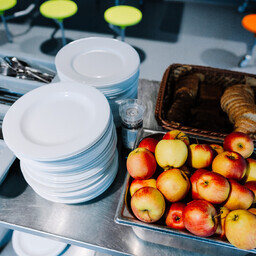Praegu kasutatakse lasteaedades ja koolides toidu nõudeid aastast 2008. Aeg on muutunud ja nüüd on valmis uus määrus. Uus määrus soodustab tervislikumat toitu.
Lapsed saavad süüa mitmekesisemalt ja tasakaalustatumalt
.
Lapsed saavad süüa mitmekesisemalt ja tasakaalustatumalt
Tõlge fraasile: Lapsed saavad süüa mitmekesisemalt ja tasakaalustatumalt
EN
Children will be able to eat more varied and balanced meals
Suurem rõhk on taimsetel toodetel
, köögiviljadel ja puuviljadel. Samuti lihtsustatakse nõudeid toitlustajatele. Nüüd ei pea kokk mõtlema mikrotoitainetele, vaid toidugruppidele nagu köögiviljad ja piimatooted.
Suurem rõhk on taimsetel toodetel
Tõlge fraasile: Suurem rõhk on taimsetel toodetel
EN
Greater emphasis is on plant-based products
Ebatervislik toit põhjustab Eestis rohkem tervisekahju
kui alkohol ja tubakas. Liiga palju sööme töödeldud liha ja soolaseid näkse. Liiga vähe sööme juur- ja puuvilju, kaunvilju ja kala.
Peame sööma rohkem taimseid toite ja kala
.
Ebatervislik toit põhjustab Eestis rohkem tervisekahju
Tõlge fraasile: Ebatervislik toit põhjustab Eestis rohkem tervisekahju
EN
Unhealthy food causes more health damage in Estonia
Peame sööma rohkem taimseid toite ja kala
Tõlge fraasile: Peame sööma rohkem taimseid toite ja kala
EN
We need to eat more plant-based foods and fish
Algkoolis hakkavad lapsed sööma rohkem suhkrut ja magusaid näkse.
Tasuta puuviljade pakkumine koolides
aitab laste kaalu langetada. Ebavõrdsus Eestis kasvab.
Koolitoidu parandamine võib vähendada laste rasvumist
15 protsenti.
Tasuta puuviljade pakkumine koolides
Tõlge fraasile: Tasuta puuviljade pakkumine koolides
EN
Free fruit offerings in schools
Koolitoidu parandamine võib vähendada laste rasvumist
Tõlge fraasile: Koolitoidu parandamine võib vähendada laste rasvumist
EN
Improving school meals can reduce childhood obesity
Lisaks toidulaua mitmekesistamisele on tähtis pakkuda erinevaid toite.
Ei tohi pakkuda liiga rasvaseid toite
nagu friikartulid. Magusaineid ei tohi pakkuda, sest
lapsed peaksid harjuma normaalsete toidu maitsetega
.
Ei tohi pakkuda liiga rasvaseid toite
Tõlge fraasile: Ei tohi pakkuda liiga rasvaseid toite
EN
You must not offer too fatty foods
lapsed peaksid harjuma normaalsete toidu maitsetega
Tõlge fraasile: lapsed peaksid harjuma normaalsete toidu maitsetega
EN
children should get used to normal food flavors
Keskkonna muutmine on tõhusam kui kampaaniad
.
Koolitoidu ümbervaatamine ja regulatsioonid on õige samm
tervislikuma elu suunas. 1. septembril jõustuv määrus puudutab ka koolipuhvetis pakutavat toitu. Koolidirektor saab otsustada, milline toit puhvetisse sobib.
Keskkonna muutmine on tõhusam kui kampaaniad
Tõlge fraasile: Keskkonna muutmine on tõhusam kui kampaaniad
EN
Changing the environment is more effective than campaigns
Koolitoidu ümbervaatamine ja regulatsioonid on õige samm
Tõlge fraasile: Koolitoidu ümbervaatamine ja regulatsioonid on õige samm
EN
Reviewing and regulating school meals is the right step
Currently, the food requirements in kindergartens and schools are based on the year 2008. Time has changed, and now a new regulation is ready. The new regulation promotes healthier food. Children will eat more varied and balanced.
Greater emphasis is placed on plant-based products, vegetables, and fruits. The requirements for caterers are also simplified. Now, the chef does not have to think about micronutrients but focuses on food groups like vegetables and dairy products.
Unhealthy food causes more health damage in Estonia than alcohol and tobacco. We eat too much processed meat and salty snacks. We eat too few root vegetables, fruits, legumes, and fish. We need to eat more plant-based foods and fish.
In primary school, children start eating more sugar and sweet snacks. Offering free fruits in schools helps reduce children’s weight. Inequality in Estonia is growing. Improving school meals can reduce childhood obesity by 15 percent.
In addition to diversifying the menu, it is important to offer different foods. Too fatty foods like French fries should not be offered. Sweeteners should not be offered because children should get used to the natural tastes of food.
Changing the environment is more effective than campaigns. The review of school meals and regulations is the right step towards a healthier life. The regulation that comes into force on September 1st also concerns the food offered in school cafeterias. The school principal can decide which food is suitable for the cafeteria.

